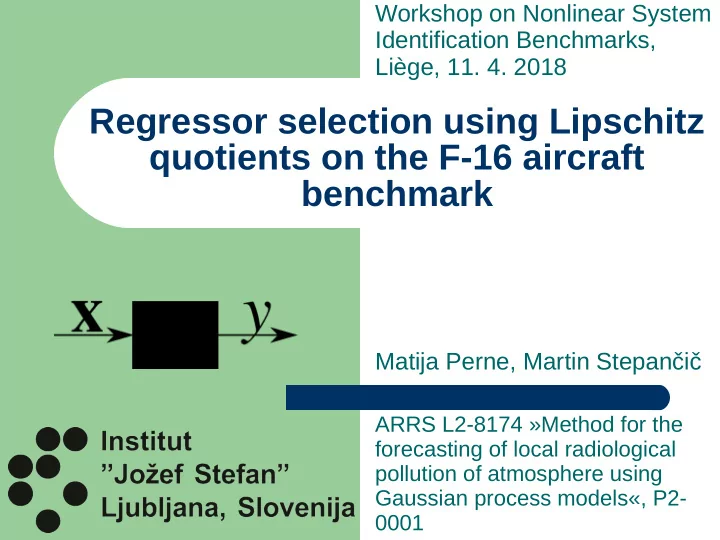

Workshop on Nonlinear System Identification Benchmarks, Liège, 11. 4. 2018 Regressor selection using Lipschitz quotients on the F-16 aircraft benchmark Matija Perne, Martin Stepančič ARRS L2-8174 »Method for the forecasting of local radiological pollution of atmosphere using Gaussian process models«, P2- 0001
Lipschitz quotients
Lipschitz quotients Process:
Lipschitz quotients Process: Lipschitz quotient:
Lipschitz quotients Process: Lipschitz quotient: Lipschitz continuity: bounded bounded
Lipschitz quotients Index:
Lipschitz quotients Index: Proposed in He & Asada (1993) for identifying system orders X. He and H. Asada, A New Method for Identifying Orders of Input-Output Models for Nonlinear Dynamic Systems, 1993 American Control Conference , San Francisco, CA, USA, 1993, pp. 2520–2523.
Lipschitz quotients Index: Proposed in He & Asada (1993) for identifying system orders Used for identifying regressors: MATLAB sequentialfs() – (sequential feature selection) – backward & forward & backward until stabilized X. He and H. Asada, A New Method for Identifying Orders of Input-Output Models for Nonlinear Dynamic Systems, 1993 American Control Conference , San Francisco, CA, USA, 1993, pp. 2520–2523.
Example
Example F-16 level 7, autoregressive model, output 2nd acceleration signal, input excitation force J.P. Noël, M. Schoukens, F-16 aircraft benchmark based on ground vibration test data
Example F-16 level 7, autoregressive model, output 2nd acceleration signal, input excitation force 14742 regressor vectors analysed – 40 components – 20 delayed inputs, 20 delayed outputs J.P. Noël, M. Schoukens, F-16 aircraft benchmark based on ground vibration test data
Example F-16 level 7, autoregressive model, output 2nd acceleration signal, input excitation force 14742 regressor vectors analysed – 40 components – 20 delayed inputs, 20 delayed outputs Regressor selection: 13 regressors selected in 10565 s J.P. Noël, M. Schoukens, F-16 aircraft benchmark based on ground vibration test data
Model performance
Model performance GP model: – squared exponential kernel (a priori with hyperparameters), zero mean, and noise with unknown variance – hyperparameters calculated through ML from regressor vectors 1474 regressor vectors used – a posteriori kernel and mean calculated from regressor vectors Prediction on level 6: e RMSt =0.0303, 73728 points in examples in 4.69 seconds (after 414 s of hyperparameter optimization) Same prediction but with all 40 regressors: e RMSt =0.0158, calculated in 5.62 seconds (after 1123 s of optimization)
Model performance GP model: – squared exponential kernel (a priori with hyperparameters), zero mean, and noise with unknown variance – hyperparameters calculated through ML from regressor vectors 1474 regressor vectors used – a posteriori kernel and mean calculated from regressor vectors Prediction on level 6: e RMSt =0.0303, 73728 points in examples in 4.69 seconds (after 414 s of hyperparameter optimization) Same prediction but with all 40 regressors: e RMSt =0.0158, calculated in 5.62 seconds (after 1123 s of optimization)
Model performance GP model: – squared exponential kernel (a priori with hyperparameters), zero mean, and noise with unknown variance – hyperparameters calculated through ML from regressor vectors 1474 regressor vectors used – a posteriori kernel and mean calculated from regressor vectors Prediction on level 6: e RMSt =0.0303, 73728 points in examples in 4.69 seconds (after 414 s of hyperparameter optimization) Same prediction but with all 40 regressors: e RMSt =0.0158, calculated in 5.62 seconds (after 1123 s of optimization)
Comparison How do models based on 13 favourite regressors of the other selection methods perform?
Comparison Method e RMSt Time for selection [s] Lipschitz 0.0303 10565 CCorr 0.0221 <1 dCorr 0.0221 272 PCorr 0.0160 6 MI 0.0218 3 PMI 0.0227 77 ANOVA 0.0191 <1 LIP (embedded) 0.0171 7560 All 40 regressors 0.0158 - ProOpter, J. Kocijan et al., Regressor selection for ozone prediction , Simulation Modelling Practice and Theory 54 (2015) 101–115
Recommend
More recommend